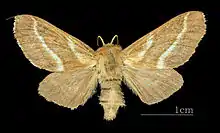Malacosoma castrense
Malacosoma castrense (or Malacosoma castrensis), the ground lackey, is a moth of the family Lasiocampidae. It is a tent caterpillar found in Europe. The species was first described by Carl Linnaeus in his 1758 10th edition of Systema Naturae.
| Ground lackey | |
|---|---|
 | |
.jpg.webp) | |
| Larvae | |
| Scientific classification | |
| Kingdom: | |
| Phylum: | |
| Class: | |
| Order: | |
| Family: | |
| Genus: | |
| Species: | M. castrense |
| Binomial name | |
| Malacosoma castrense | |
| Synonyms | |
| |
The length of the forewings is 13–16 mm for males and 17–21 mm for females. The moth flies from June to August, depending on the location.
The caterpillars feed on various shrubs and herbaceous plants such as heather, cypress spurge, and Lotus species.
Subspecies
- Malacosoma castrense castrense
- Malacosoma castrense kirghisicum (Staudinger, 1879) (Asia Minor, Kazakhstan, Turkmenia, Uzbekistan)
- Malacosoma castrense thomalae Gaede, 1932 (Tien-Shan)
External links
| Wikimedia Commons has media related to Malacosoma castrense. |
- Kimber, Ian. "66.004 BF1635 Ground Lackey Malacosoma castrensis (Linnaeus, 1758)". UKMoths. Retrieved 3 July 2019.
- Lepidoptera of Belgium
- Lepiforum e.V.
- De Vlinderstichting (in Dutch)
This article is issued from Wikipedia. The text is licensed under Creative Commons - Attribution - Sharealike. Additional terms may apply for the media files.